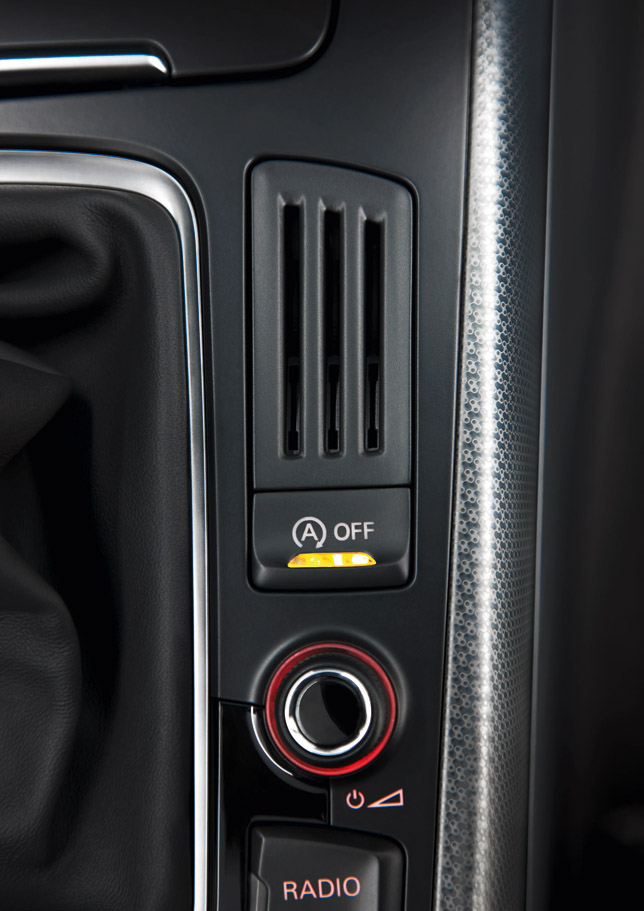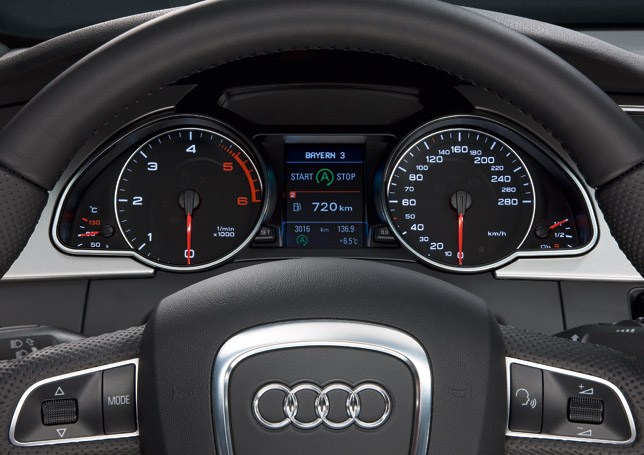Driving efficiently: new technologies from Audi
Audi is consistently pressing forward to improve fuel economy and CO2 emissions. Starting in the second quarter of 2009, the modular efficiency platform will benefit from additional new technologies: The on-board computer with the efficiency program and the start-stop system will raise the efficiency and convenience of the Audi models to a new level. By 2012 the fuel consumption of the Audi model range should drop by 20 percent.
Audi's modular efficiency platform combines reduced consumption with great driveability and outstanding sportiness. And now Audi is bringing two additional efficiency technologies up to the starting line: the start-stop system and the on-board computer with efficiency program. These complement the energy recovery system, which already belongs to the standard specification of many Audi models and feeds energy back into the vehicle's electrical system during deceleration phases.
The start-stop system realizes its efficiency potential especially in urban traffic, significantly reducing consumption while relieving the driver: The system shuts down the engine once the car has come to a stop, the gear lever stands at idle and the driver releases the clutch pedal. Operating the clutch then starts up the engine again. The start-stop system is extremely quiet, convenient to operate, and fast: The engine returns to idle speed while the driver is shifting gears.
Audi combines the start-stop system with efficient battery technology and sophisticated energy management, to maintain functioning even at low temperatures. The system is inactive during the warm-up phase of the engine, so that the engine oil becomes warmer and the exhaust gas cleaning systems reach their operating temperature faster. The driver can also switch off the start-stop system at any time by pressing a button.

In the standardized driving cycle the start-stop system lowers fuel consumption by about 0.2 liters per 100 km, and therefore reduces CO2 emissions by around 5 g/km. The new system is being used for the first time in the Audi A3 1.4 TFSI with manual transmission and in the Audi A4 and A5 with two-liter engines and manual gearshift. Numerous other models will follow this year.
The second newcomer in the modular efficiency platform is the on-board computer with the efficiency program, an addition to the Audi Driver Information System. All consumption-related data appear in the center display, with recommendations for efficient driving – after all, up to 30 percent of fuel consumption depends on the individual driving style. The efficiency program continuously analyzes the energy consumption in the vehicle and gives the driver up-to-date tips for saving fuel, depending on the driving situation and driving style.
The newly designed gearshift indicator signals to the driver when to shift, for optimal fuel economy: A large and color-coded display indicates whether the right gear is engaged, or whether shifting would be practical for the sake of efficiency. Comfort features like air conditioning and seat heating also increase fuel consumption. A specially developed display in the efficiency program identifies the systems requiring extra energy and indicates their share in fuel consumption.
The energy recovery system already uses deceleration phases to convert kinetic energy into electrical energy. When the car accelerates again, the battery directs the temporarily stored energy back into the vehicle, to relieve the alternator and thereby save fuel. The energy recovery system is already standard equipment on the Audi A3 1.4 TFSI with manual transmission, the Audi A4, A5 Coupé and A5 Cabriolet with two-liter engine and manual transmission, the A6 and the Audi Q5 and Q7.
From innovative powertrain technologies to highly efficient air conditioning, the goal of the modular efficiency platform is to improve the entire vehicle's energy management. And Audi's efficiency technologies are systematically geared to the driver's needs.

The modular efficiency platform focuses on the further development of powertrain and transmission technologies, and the recovery and storage of mechanical, thermal and electrical energy. Audi also employs a host of measures to minimize driving resistance and optimize aerodynamics. These benefits are made tangible for the driver by a range of innovative assistance systems, with the standard specification of many current Audi models already featuring numerous efficiency technologies such as the Audi valvelift system, high-efficiency transmission and tires with optimized rolling resistance.
By 2012 Audi plans to lower the fuel consumption of its model range by 20 percent compared with the 2007 level. The brand will then have further enhanced its sporty and progressive profile, for efficiency and sportiness are inextricably linked at Audi.








